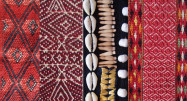English version below
135 groupes ethniques composent officiellement la Birmanie, et tous ont leur tradition de tissages.
La variété des tissages reflète celle du pays ; ils représentent la diversité ethnique et la richesse des savoirs-faire. Qu’ils soient petits, grands, longs, courts, tubulaires… les tissages sont vêtements ou objets rituels.
Porter un vêtement, des bijoux, c’est se conformer à l’usage et affirmer son appartenance au groupe. Au fil du temps, les tissages varient, témoignant de l’évolution du groupe et de ses relations avec les groupes voisins. Parfois, on adopte un motif, parfois un fil de couleur vive et brillante apparu sur un marché. Si les techniques perdurent, la finesse des points, les fils, la nature des teintures et même les motifs changent, parfois décevants : on laisse une teinture naturelle pour une autre chimique, venue de l’Inde… Ces changements sont le signe d’une adaptation mais aussi la certitude qu’ils continueront à être tissés et portés.
Porter un tissage ethnique, c’est appartenir au groupe. En Birmanie, plus on s’éloigne de la zone centrale, plus on rencontre de groupes ethniques. Certains sont en survie ; tous portent leur costume, au moins pour les fêtes, façon symbolique d’afficher leur identité, de défendre leur culture.
À l’heure actuelle, certains tissages ont disparu, ne sont plus fabriqués, montrant la précarité de ces cultures, différentes et menacées.
Quelques livres sur les tissages ethniques et l\’artisanat :
Elisabeth Dell et Sandra Dudley, Textiles from Burma, Art Media Ressources, Chicago, 2003, 192 pages
David W. et Barbara G. Fraser, Mantles of Merit, Chin textiles from Myanmar, India and Bengladesh, River Books, Bangkok, 2005, 288 pages
Julian Jacobs, Les Naga, montagnards entre Inde et Birmanie, éditions Olizane, Genève , 1989, 358 pages
Richard K. Diran, Birmanie, un monde qui disparait, Gründ, Paris, 1998, 237 pages
135 ethnic groups officially make up Burma, and all have their weaving tradition. The variety of weavings reflects that of the country; they represent the ethnic diversity and the wealth of know-how.
Whether they are small, large, long, short, tubular… weaving are garments or ritual objects.
Wearing a garment, jewelry means belonging to the group. Over time, weaving changes, reflecting the evolution of the group and its relationships with neighbouring groups. Sometimes they adopt a pattern, sometimes a bright colored thread that appeared in a market.
If the techniques persist, the fineness of the points and threads, the nature of the tincture and even the patterns change, sometimes disappointing. They leave a natural tincture for another chemical, from India… These changes are the sign of an adaptation but also the certainty that textiles will continue to be woven and worn.
Wearing an ethnic weaving is belonging to the group. In Burma, the further away you get from the central area, the more ethnic groups you meet. Some are in survival; all wear their costumes, at least for the ceremonies, a symbolic way to show their identity and defend their culture.
Nowadays, some weavings have disappeared, because the group has disappeared showing the precariousness of these cultures..
Some books on ethnic weaving and crafts:
Elisabeth Dell and Sandra Dudley, Textiles from Burma, Art Media Resources, Chicago, 2003, 192 pages
David W. and Barbara G. Fraser, Mantles of Merit, Chin textiles from Myanmar, India and Bangladesh, River Books, Bangkok, 2005, 288 pages
Julian Jacobs, Les Naga, montagnards entre Inde et Birmanie, éditions Olizane, Genève , 1989, 358 pages
Richard K. Diran, Birmanie, un monde qui disparait, Gründ, Paris, 1998, 237 pages
